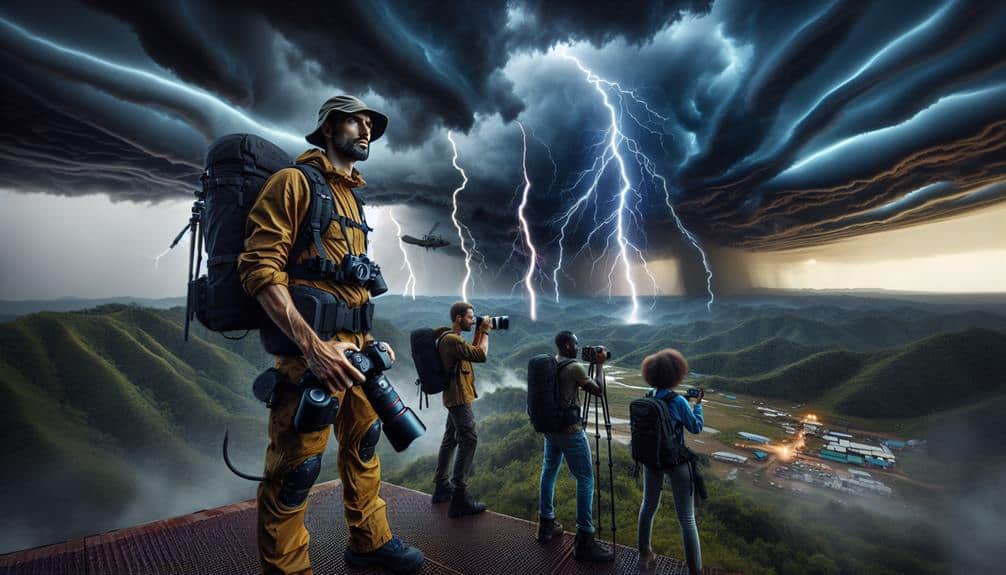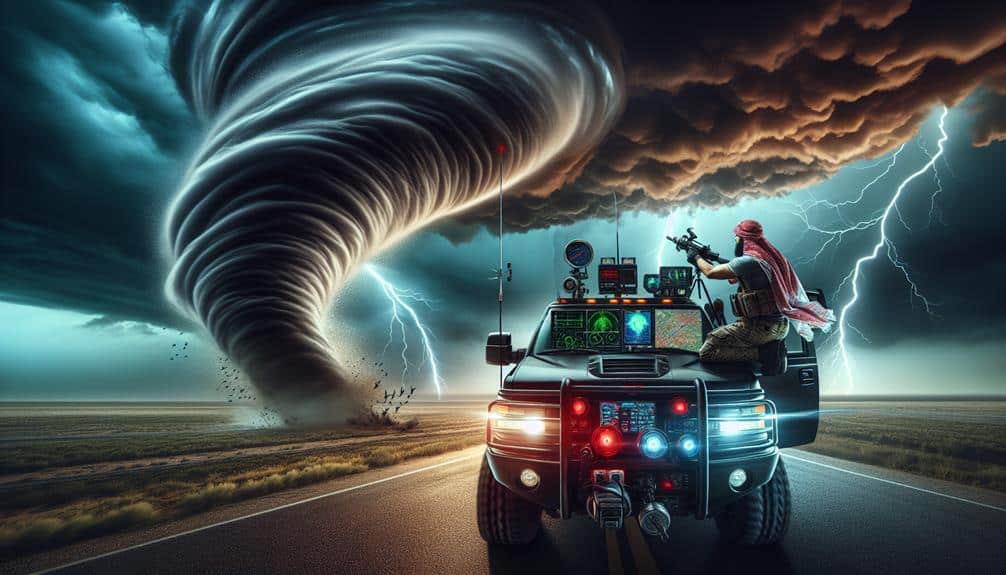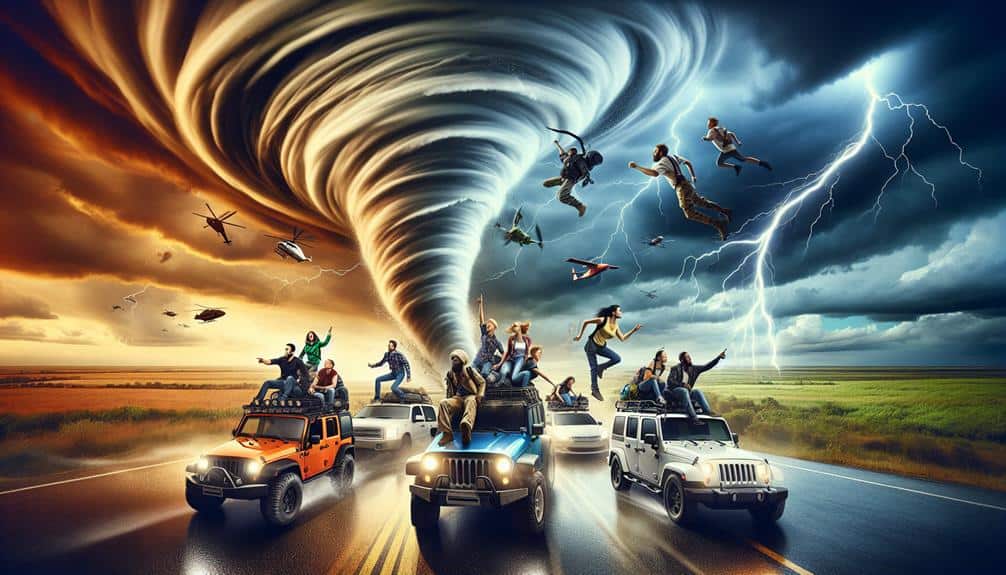When conducting storm chasing risk assessment, we assess multiple key components, involving meteorological hazards, terrain, and road conditions. We rely heavily on Doppler radar and atmospheric data to predict storms. Evaluating topographical maps and real-time data helps us navigate safely. Vehicle preparedness, including maintenance and emergency supplies, is vital. Robust communication protocols are necessary for team safety and coordination. Additionally, we analyze team experience to guarantee effective decision-making under pressure. Monitoring real-time weather data and having a detailed equipment inventory further enhances our operational efficiency. By understanding these elements, our storm chasing efforts can be both effective and secure.
Key Points
- Identifying Meteorological Hazards: Analyze weather data to predict tornadoes, lightning, and hail using radar and atmospheric soundings.
- Evaluating Terrain and Road Conditions: Use topographical maps and real-time data to navigate safely and avoid flood-prone or compromised roads.
- Assessing Vehicle Preparedness: Ensure vehicle maintenance and equip with emergency supplies and specialized weather monitoring gear.
- Understanding Communication Protocols: Establish reliable communication systems for real-time data sharing and emergency coordination.
Identifying Meteorological Hazards
When identifying meteorological hazards, we must focus on key factors such as tornado genesis, lightning strikes, hail, and flash flooding patterns.
Tornado genesis involves understanding supercell dynamics, wind shear, and thermal instability. We rely on Doppler radar data and atmospheric soundings to detect rotation and predict tornado formation. Accurate identification allows us to implement safety measures, such as positioning ourselves perpendicular to the storm's path to avoid direct encounters.
Lightning strikes pose significant risks, especially in open areas. We monitor cloud-to-ground lightning frequency using lightning detection networks. By maintaining a safe distance and utilizing grounded vehicles, we minimize our exposure.
Hailstorms, another vital hazard, result from strong updrafts within thunderstorms. Hail size and fall speed can cause severe damage, so we deploy hail pads to measure impact and adjust our positioning to reduce vehicle damage.
Flash flooding patterns are influenced by precipitation rates and topography. Hydrological models and real-time rainfall data enable us to anticipate flood-prone areas. Adhering to safety measures, like avoiding low-water crossings and staying updated with National Weather Service alerts, is essential.
Evaluating Terrain and Road Conditions
Understanding meteorological hazards is only part of the equation; we must also rigorously assess terrain and road conditions to guarantee our safety during storm chases. Detailed analysis of topographical maps is essential to anticipate potential obstacles. For instance, we need to identify flood-prone areas that could become impassable. Knowing the layout of rural versus urban road networks helps us plan escape routes.
Weather patterns heavily influence road conditions. Heavy rain can lead to flash flooding, while high winds might scatter debris across our path. We rely on real-time data from meteorological stations to monitor these conditions and adjust our course accordingly. Additionally, satellite imagery aids in identifying areas where recent weather events have compromised road integrity.
Vehicle safety is paramount. Before setting out, we should inspect road surfaces for wear and tear, particularly in regions frequently affected by severe weather. Muddy or unpaved roads can be hazardous, especially after prolonged rainfall. We must also be aware of seasonal variations; winter conditions can introduce ice and snow, further complicating our route.
Assessing Vehicle Preparedness
Securing our vehicles are fully equipped and mechanically sound is crucial for the challenging conditions encountered during storm chases. We must prioritize vehicle maintenance to guarantee reliability under extreme weather scenarios. Regular inspection and servicing of the engine, brakes, tires, and electrical systems are non-negotiable. Securing fluid levels, such as oil and coolant, are optimal is necessary for preventing breakdowns.
Our equipment checklist should include emergency supplies like spare tires, jacks, jumper cables, and tire repair kits. Additionally, we need to carry essential tools and spare parts that might be crucial for on-the-spot fixes. A well-stocked first aid kit and fire extinguisher are essential safety measures.
We also need to install specialized equipment such as weather radar, dash cams, and GPS units for real-time data acquisition and navigation. High-quality communication devices are crucial, though we'll discuss protocols separately. To enhance safety, our vehicles should have reinforced windows and storm guards.
Data-driven decisions hinge on our preparedness, making a thorough vehicle inspection an indispensable part of our pre-chase routine. By meticulously adhering to a detailed maintenance and equipment checklist, we secure that our pursuit of freedom in storm chasing remains safe and efficient.
Understanding Communication Protocols
Effective communication protocols are fundamental for coordinating team movements and ensuring real-time data sharing during storm chases. We need to establish a robust system for emergency communication that allows for immediate responses to changing conditions.
Real-time weather updates from radar, satellite, and ground observations must be seamlessly integrated into our communication network, ensuring that every team member is aware of the latest developments.
Our use of radio frequencies and cellular networks must be optimized for reliability, even in remote areas. Satellite phones can serve as an essential backup when conventional networks fail. We should also implement standardized codes and signals to minimize misunderstandings during high-stress situations.
In addition, data-sharing platforms like GPS tracking and mobile apps should be used to relay precise location information instantly. This not only enhances situational awareness but also allows us to make informed decisions quickly.
We must regularly test and refine these protocols through drills and simulations, ensuring we're prepared for any scenario.
Analyzing Team Experience and Skills

To accurately assess our team's readiness for storm chasing, we must carefully evaluate each member's experience, skill set, and specialized training. Effective team dynamics are vital in high-stress environments, necessitating a thorough analysis of how well our members collaborate under pressure.
Each individual's past storm chasing experiences provide valuable data points that influence our overall risk assessment. Skill development is another pivotal factor. We need to guarantee all team members have undergone rigorous training in meteorological data interpretation, navigation, and emergency medical response.
This specialized training enhances our ability to make real-time decisions, greatly reducing potential risks. Simultaneously, our team's leadership must be adept at crisis management, capable of making quick, informed decisions that prioritize safety and operational success.
We employ data-driven methods to quantify and evaluate these competencies, including performance metrics from previous chases and simulation exercises. By doing so, we can identify gaps in skill sets and areas where additional training is required.
Our goal is to create a cohesive unit where each member's strengths are leveraged, and weaknesses are addressed, ensuring we operate with maximum efficiency and minimal risk. This rigorous approach to evaluating team experience and skills is essential for safe and successful storm chasing.
Reviewing Emergency Response Plans
Let's start by identifying our response procedures, ensuring they're thorough and up-to-date.
We'll then review our communication protocols to confirm all team members can stay in constant contact during an emergency.
Identifying Response Procedures
How do we systematically evaluate and refine our emergency response plans to guarantee maximum efficiency and safety during storm chasing operations? To achieve this, we need to integrate response coordination and safety protocols into our procedures. Our primary goal is to ensure that every team member understands their role and can act swiftly under pressure.
Here are the steps we can take:
- Risk Identification: Assess potential hazards specific to storm chasing, such as tornadoes, flash floods, and lightning.
- Resource Allocation: Designate essential resources, including vehicles, communication devices, first aid kits, and protective gear.
- Role Assignment: Clearly define each team member's responsibilities to streamline response coordination and minimize confusion during emergencies.
- Safety Protocols: Implement and regularly update safety protocols based on the latest meteorological data and field experiences.
Communication Protocols Overview
Effective storm chasing hinges on robust communication protocols that secure all team members are informed, coordinated, and able to respond swiftly to evolving weather conditions. We can't overemphasize the importance of real-time weather updates and clear, well-defined safety procedures. These protocols are the backbone of our operations, minimizing risk and maximizing our ability to track and analyze severe weather phenomena.
Our communication system integrates several layers of redundancy to guarantee reliability. We utilize radio frequencies, satellite phones, and digital messaging platforms to maintain constant contact. This multi-channel approach ensures that even if one method fails, others are available to keep the information flowing.
Weather updates are disseminated through a centralized command system, which interprets data from radar, satellite imagery, and meteorological models. This data-driven strategy ensures we're always ahead of the storm, allowing us to make informed decisions rapidly.
Moreover, our safety procedures are meticulously detailed and regularly reviewed. Each team member knows their role and the specific actions to take in various emergency scenarios.
Equipment and Resources Inventory
Maintaining a meticulously detailed inventory of equipment and resources is crucial to confirming our emergency response plans are actionable and effective. We acknowledge that an exhaustive equipment checklist not only supports our safety protocols but also enhances our operational efficiency. As storm chasers, our freedom to navigate volatile weather patterns depends on the reliability and readiness of our gear.
Our inventory should encompass:
1. Meteorological Instruments:
Doppler radar units, anemometers, and barometers to provide real-time data.
2. Communication Devices:
Satellite phones, two-way radios, and GPS units to maintain connectivity and coordinate movements.
3. Safety Gear:
Helmets, high-visibility vests, and first-aid kits to minimize risk and guarantee immediate response to injuries.
4. Vehicle Essentials:
Spare tires, fuel reserves, and maintenance tools to keep us mobile under extreme conditions.
Monitoring Real-Time Weather Data
In monitoring real-time weather data, we rely on a combination of satellite imagery, radar systems, and weather station outputs to track storm developments.
Utilizing advanced technology such as Doppler radar and GIS mapping tools, we can analyze data with high precision.
Data Sources Utilized
Storm chasers depend on a combination of radar data, satellite imagery, and ground-based observations to monitor real-time weather conditions and assess potential risks. These data sources are essential for effective data collection and analysis, enabling us to develop risk mitigation strategies that keep us safe while pursuing the thrill of the storm.
- Radar Data: Doppler radar provides real-time information on precipitation intensity, storm structure, and wind velocity. This data is invaluable for identifying rotation and potential tornado formation.
- Satellite Imagery: High-resolution satellite images offer an expansive view of weather systems, helping us track storm development and movement over large areas.
- Ground-Based Observations: Reports from weather stations, storm spotters, and mobile units provide localized data on temperature, humidity, wind speed, and storm impact.
- Weather Models: Numerical weather prediction models integrate various data inputs to forecast storm evolution, giving us a predictive edge.
Technology and Tools
We depend on advanced technology and specialized tools to monitor real-time weather data, ensuring accurate and timely information for effective storm chasing. Tech advancements have greatly enhanced our forecasting accuracy, allowing us to anticipate storm developments with exceptional precision. High-resolution radar systems and satellite imaging play pivotal roles by providing detailed insights into atmospheric conditions. These tools enable us to detect and analyze storm structures, track their movement, and predict potential intensification.
Remote sensing technologies, including Doppler radar and LIDAR (Light Detection and Ranging), are indispensable for storm tracking. They offer real-time data on wind speed, precipitation, and storm cell location. This data is essential for identifying severe weather phenomena such as tornadoes, hailstorms, and flash floods.
Mobile weather stations and drones equipped with meteorological sensors further enhance our data collection capabilities by providing localized, ground-level observations.
Moreover, advanced computational models integrate this real-time data to simulate storm behavior and produce more accurate forecasts. These models use algorithms that process vast datasets, facilitating near-instantaneous updates to our storm tracking systems. By leveraging these tech advancements, we can make informed decisions, minimize risks, and maximize the excitement of storm chasing while prioritizing safety.
Interpreting Weather Patterns
Leveraging our advanced technology and tools, we interpret real-time weather data to identify and understand evolving storm patterns with utmost accuracy. Weather tracking is vital in storm chasing, and our ability to analyze this data in real time enables us to make informed decisions swiftly.
By monitoring radar visuals, satellite information, and atmospheric conditions, we can predict storm trajectories and potential intensities.
Radar Visuals: Provides us with real-time precipitation data, allowing us to see the storm's structure and movement.
Satellite Information: Offers a broader view of weather systems, helping us track the development of large-scale storm patterns.
Atmospheric Readings: Measure temperature, humidity, and wind profiles at various altitudes, providing essential parameters for storm prediction.
Model Simulations: Utilize computational models to forecast storm behavior based on current and historical data.
These tools together form a thorough weather tracking system that enhances our storm prediction capabilities. By integrating various data sources, we generate a robust situational awareness that guides our actions.
This detailed approach not only ensures our safety but also empowers us to pursue our passion for storm chasing with greater confidence and freedom.
Frequently Asked Questions
What Personal Protective Equipment Is Recommended for Storm Chasers?
For storm chasers, our equipment selection includes helmets, reinforced clothing, and goggles. We follow safety protocols and prioritize risk mitigation by constantly weather monitoring. These measures guarantee our safety while allowing us to experience the thrill freely.
How Do Storm Chasers Manage Mental Stress and Fatigue During Missions?
We employ stress management and coping strategies to maintain mental health and build resilience. Regular breaks, mindfulness exercises, and peer support help us manage mental stress and fatigue, ensuring we're always ready for the next storm.
What Insurance Considerations Should Storm Chasers Be Aware Of?
We must make sure our insurance coverage is thorough, including liability protection to safeguard against potential damages or injuries. Evaluating policy specifics and exclusions is vital for minimizing financial risk during our storm chasing missions.
How Can Storm Chasers Maintain Health and Nutrition on the Road?
To uphold health and nutrition on the road, we prioritize meal planning and an exercise routine. By prepping balanced meals and scheduling regular workouts, we guarantee sustained energy and resilience during our storm chasing adventures.
What Are the Legal Implications of Storm Chasing in Different Regions?
Dancing with the wind, we navigate liability concerns and regional regulations. Each area has its own storm-chasing laws, requiring us to stay informed. Understanding these legal frameworks guarantees our adventures are both thrilling and compliant.


